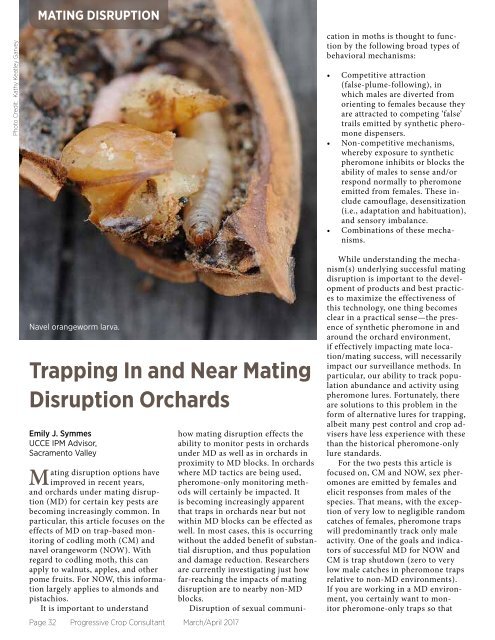Mar_Apr_PCC_2017_Web
You also want an ePaper? Increase the reach of your titles
YUMPU automatically turns print PDFs into web optimized ePapers that Google loves.
MATING DISRUPTION<br />
Photo Credit: Kathy Keatley Garvey<br />
how mating disruption effects the<br />
ability to monitor pests in orchards<br />
under MD as well as in orchards in<br />
proximity to MD blocks. In orchards<br />
where MD tactics are being used,<br />
pheromone-only monitoring methods<br />
will certainly be impacted. It<br />
is becoming increasingly apparent<br />
that traps in orchards near but not<br />
within MD blocks can be effected as<br />
well. In most cases, this is occurring<br />
without the added benefit of substantial<br />
disruption, and thus population<br />
and damage reduction. Researchers<br />
are currently investigating just how<br />
far-reaching the impacts of mating<br />
disruption are to nearby non-MD<br />
blocks.<br />
Disruption of sexual communication<br />
in moths is thought to function<br />
by the following broad types of<br />
behavioral mechanisms:<br />
• Competitive attraction<br />
(false-plume-following), in<br />
which males are diverted from<br />
orienting to females because they<br />
are attracted to competing ‘false’<br />
trails emitted by synthetic pheromone<br />
dispensers.<br />
• Non-competitive mechanisms,<br />
whereby exposure to synthetic<br />
pheromone inhibits or blocks the<br />
ability of males to sense and/or<br />
respond normally to pheromone<br />
emitted from females. These include<br />
camouflage, desensitization<br />
(i.e., adaptation and habituation),<br />
and sensory imbalance.<br />
• Combinations of these mechanisms.<br />
Navel orangeworm larva.<br />
Trapping In and Near Mating<br />
Disruption Orchards<br />
Emily J. Symmes<br />
UCCE IPM Advisor,<br />
Sacramento Valley<br />
Mating disruption options have<br />
improved in recent years,<br />
and orchards under mating disruption<br />
(MD) for certain key pests are<br />
becoming increasingly common. In<br />
particular, this article focuses on the<br />
effects of MD on trap-based monitoring<br />
of codling moth (CM) and<br />
navel orangeworm (NOW). With<br />
regard to codling moth, this can<br />
apply to walnuts, apples, and other<br />
pome fruits. For NOW, this information<br />
largely applies to almonds and<br />
pistachios.<br />
It is important to understand<br />
Page 32 Progressive Crop Consultant <strong>Mar</strong>ch/<strong>Apr</strong>il <strong>2017</strong><br />
While understanding the mechanism(s)<br />
underlying successful mating<br />
disruption is important to the development<br />
of products and best practices<br />
to maximize the effectiveness of<br />
this technology, one thing becomes<br />
clear in a practical sense—the presence<br />
of synthetic pheromone in and<br />
around the orchard environment,<br />
if effectively impacting mate location/mating<br />
success, will necessarily<br />
impact our surveillance methods. In<br />
particular, our ability to track population<br />
abundance and activity using<br />
pheromone lures. Fortunately, there<br />
are solutions to this problem in the<br />
form of alternative lures for trapping,<br />
albeit many pest control and crop advisers<br />
have less experience with these<br />
than the historical pheromone-only<br />
lure standards.<br />
For the two pests this article is<br />
focused on, CM and NOW, sex pheromones<br />
are emitted by females and<br />
elicit responses from males of the<br />
species. That means, with the exception<br />
of very low to negligible random<br />
catches of females, pheromone traps<br />
will predominantly track only male<br />
activity. One of the goals and indicators<br />
of successful MD for NOW and<br />
CM is trap shutdown (zero to very<br />
low male catches in pheromone traps<br />
relative to non-MD environments).<br />
If you are working in a MD environment,<br />
you certainly want to monitor<br />
pheromone-only traps so that


















